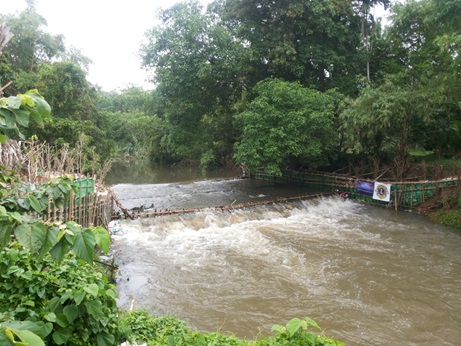

The living weir concept is an EbA Measure, which is based on the knowledge of the local communities in the river basin and in line with the King of Thailand’s Sufficiency Economy Philosophy to apply technologies based on local resources and know-how. In a first stage a bamboo grid construction is constructed in the river providing structure for degradable sand bags containing a mixture of sand, coconut coir and manure. Along the riverbanks a combination of Banyan trees (Ficus bengalensis) and other leguminous plants is planted to stabilize soils. The wide rooting banyan trees are planted on both side of the weir, The roots that they are forming will nurture from the manure and will penetrate in the bamboo construction over the next decades to form a “living weir”. This technology entails several benefits such as improving ground water recharge, which can increase the crop yields, increasing biodiversity, such as increasing in fish habitat, variety of plants etc. and strengthen unity among related stakeholders. Terraces also allow fish to move upstream. Maintenance costs and efforts for this methodology are low and can be easily conducted by the local communities.
• Local acceptance & ownership • clarity on land tenure on construction site • stakeholder involvement, such as local people, (ideally with support from government and private sector) • natural materials that are available in the area such as bamboo, sandbags, tree seedlings etc. • working on voluntary basis, budget and material support by community at the first stage, support from the government and/or private sector at a later stage
- Being seen as a local wisdom, these measures have the full support from the local community and are financed and implemented by local stakeholders. This has gained them a lot of attention and interests from Thai government institutions. - However, there is a lack of scientific backup. This leads to construction without proper planning and without coordination with the local water management institutions. In the past newly constructed weirs were built in wrong locations at the wrong time, underestimating the river flow during an early flood season , which caused damage or even destruction of the incomplete structures - Raising awareness on physical and socioeconomic impacts of climate change has increased the acceptance of EbA measures by local stakeholders. However, further knowledge is needed to erase belief on false effects of EbA measures and to convey to stakeholders in which locations EbA measures are feasible.